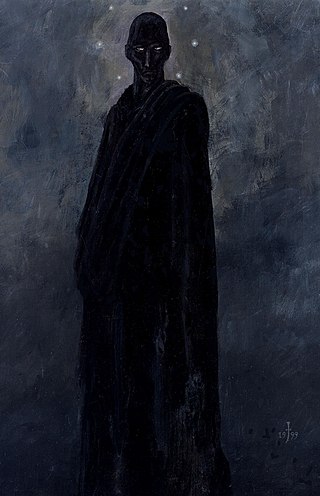
Nyarlathotep is a fictional character created by H. P. Lovecraft. The character is a malign deity in the Cthulhu Mythos, a shared universe. First appearing in Lovecraft's 1920 prose poem "Nyarlathotep", he was later mentioned in other works by Lovecraft and by other writers, to the point of often being considered the main antagonist of the Cthulhu Mythos as a whole. He is presented as the messenger of Azathoth. He is later described by other authors as being part of the Other Gods, an alien pantheon.

Azathoth is a deity in the Cthulhu Mythos and Dream Cycle stories of writer H. P. Lovecraft and other authors. He is the supreme deity of the Cthulhu Mythos and the ruler of the Outer Gods, and may also be seen as a symbol for primordial chaos, therefore being the most powerful entity in the entirety of the Cthulhu Mythos.

"The Colour Out of Space" is a science fiction/horror short story by American author H. P. Lovecraft, written in March 1927. In the tale, an unnamed narrator pieces together the story of an area known by the locals as the "blasted heath" in the hills west of the fictional town of Arkham, Massachusetts. The narrator discovers that many years ago a meteorite crashed there, poisoning every living being nearby: vegetation grows large but foul-tasting, animals are driven mad and deformed into grotesque shapes, and the people go insane or die one by one.

The Dream-Quest of Unknown Kadath is a Horror novella by American writer H. P. Lovecraft. Begun probably in the autumn of 1926, the draft was completed on January 22, 1927 and it remained unrevised and unpublished in his lifetime. It is both the longest of the stories that make up his Dream Cycle and the longest Lovecraft work to feature protagonist Randolph Carter. Along with his 1927 novel The Case of Charles Dexter Ward, it can be considered one of the significant achievements of that period of Lovecraft's writing. The Dream-Quest combines elements of horror and fantasy into an epic tale that illustrates the scope and wonder of humankind's ability to dream.
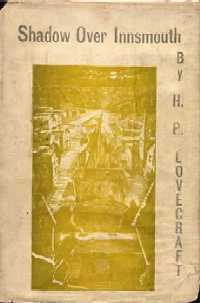
The Shadow over Innsmouth is a horror novella by American author H. P. Lovecraft, written in November–December 1931. It forms part of the Cthulhu Mythos, using its motif of a malign undersea civilization, and references several shared elements of the Mythos, including place-names, mythical creatures, and invocations. The Shadow over Innsmouth is the only Lovecraft story that was published in book form during his lifetime.

"The Nameless City" is a short horror story written by American writer H. P. Lovecraft in January 1921 and first published in the November 1921 issue of the amateur press journal The Wolverine. It is often considered the first story set in the Cthulhu Mythos world. In the story, the protagonist travels to the middle of the Arabian Desert to explore an ancient underground city.
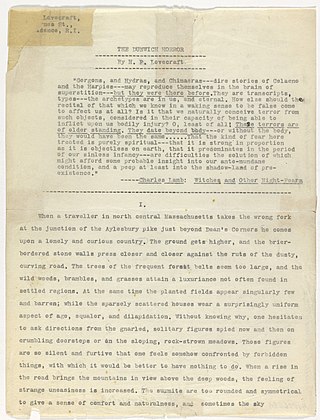
"The Dunwich Horror" is a horror novella by American writer H. P. Lovecraft. Written in 1928, it was first published in the April 1929 issue of Weird Tales (pp. 481–508). It takes place in Dunwich, a fictional town in Massachusetts. It is considered one of the core stories of the Cthulhu Mythos.

Lovecraftian horror, also called cosmic horror or eldritch horror, is a subgenre of horror, fantasy fiction and weird fiction that emphasizes the horror of the unknowable and incomprehensible more than gore or other elements of shock. It is named after American author H. P. Lovecraft (1890–1937). His work emphasizes themes of cosmic dread, forbidden and dangerous knowledge, madness, non-human influences on humanity, religion and superstition, fate and inevitability, and the risks associated with scientific discoveries, which are now associated with Lovecraftian horror as a subgenre. The cosmic themes of Lovecraftian horror can also be found in other media, notably horror films, horror games, and comics.

"In the Walls of Eryx" is a short story by American writers H. P. Lovecraft and Kenneth J. Sterling, written in January 1936 and first published in Weird Tales magazine in October 1939. It is a science fiction story involving space exploration in the near future.

"The Outsider" is a short story by American horror writer H. P. Lovecraft. Written between March and August 1921, it was first published in Weird Tales, April 1926. In this work, a mysterious individual who has been living alone in a castle for as long as he can remember decides to break free in search of human contact and light. "The Outsider" is one of Lovecraft's most commonly reprinted works and is also one of the most popular stories ever to be published in Weird Tales.

"Dagon" is a short story by American author H. P. Lovecraft. It was written in July 1917 and is one of the first stories that Lovecraft wrote as an adult. It was first published in the November 1919 edition of The Vagrant. Dagon was later published in Weird Tales in October 1923. It is considered by many to be one of Lovecraft's most forward-looking stories.

"From Beyond" is a horror genre short story by American writer H. P. Lovecraft. It was written in 1920 and was first published in The Fantasy Fan in June 1934.
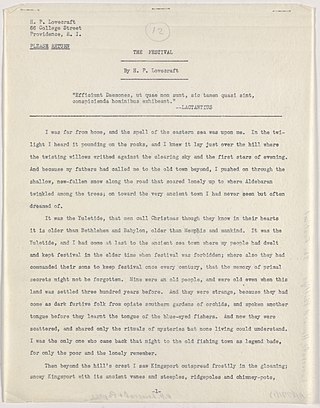
"The Festival" is a short story by H. P. Lovecraft written in October 1923 and published in the January 1925 issue of Weird Tales.
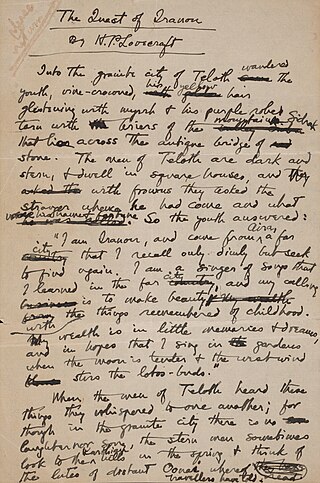
"The Quest of Iranon" is a fantasy short story by American writer H. P. Lovecraft. It was written on February 28, 1921, and was first published in the July/August 1935 issue of the magazine Galleon. It was later reprinted in Weird Tales in 1939.

"The Hound" is a short story written by H. P. Lovecraft in September 1922 and published in the February 1924 issue of Weird Tales. It contains the first mention of Lovecraft's fictional text the Necronomicon.
"The Dreams in the Witch House" is a horror short story by American writer H. P. Lovecraft, part of the Cthulhu Mythos cycle. It was written in January/February 1932 and first published in the July 1933 issue of Weird Tales.

"Nyarlathotep" is a weird fiction short story by H. P. Lovecraft. It was written in 1920 and first saw publication in that year's November issue of The United Amateur. The poem itself is a bleak view of human civilization in decline, and it explores the mixed sensations of desperation and defiance in a dying society.
"The Green Meadow" is a short story by H. P. Lovecraft and Winifred V. Jackson written in 1918/1919 and published in the spring 1927 issue of The Vagrant. As in their other collaboration, "The Crawling Chaos", both authors used pseudonyms — the tale was published as by "Elizabeth Neville Berkeley" (Jackson) and "Lewis Theobald, Jun." (Lovecraft). Lovecraft wrote the entire text but Jackson is credited since it was based on a dream she had experienced.

Cthulhu Mythos deities are a group of fictional deities created by American author H. P. Lovecraft (1890–1937), and later expanded by others in the fictional universe known as the Cthulhu mythos.
"Poetry and the Gods" is a short story by H. P. Lovecraft and Anna Helen Crofts. The two authors wrote the story in or shortly before the summer of 1920. It was published the following September in United Amateur, which credits Lovecraft as Henry Paget-Lowe. In the story, a young woman dreams that she has an audience with Zeus, who explains to her that the gods have been asleep and dreaming, but they have chosen a poet who will herald their awakening.
















